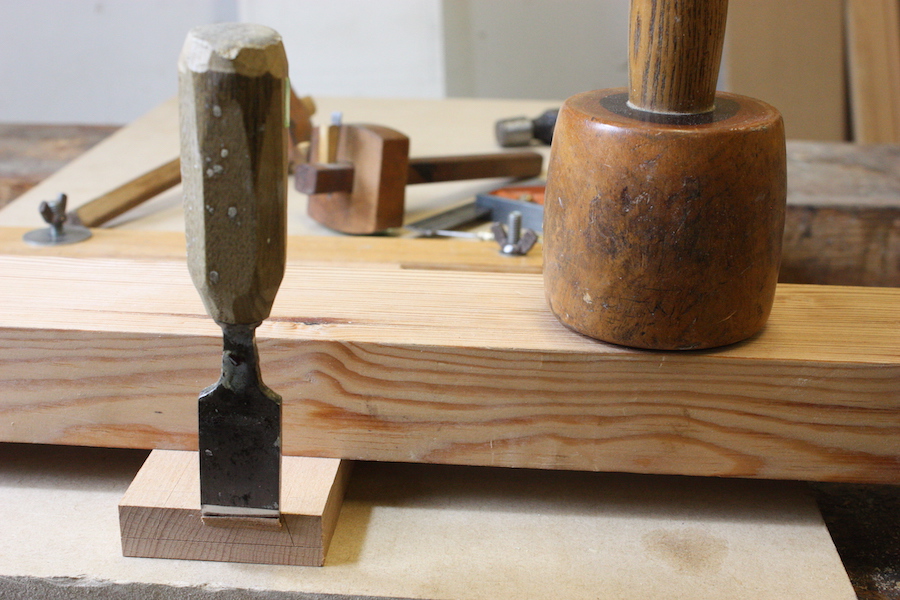Jacob
Pint of bass, porkpie, and packet of crisps please
Tried the cutting and splitting method. On the face of it it should be efficient but I don't think it is. Took some thought to find out why:
1. Chopping in to the wood at the back of the socket needs much more force for the same depth of cut, compared to chopping at the face, where the waste just falls away, as in photo

2 Moving from chop to split is a change of position (there's a lot of these to do so that's a lot of changes)
3 Splitting somewhat unpredictable and untidy, needs more cleaning up.
So I'm happy with all chopping, no splitting, no saw cuts.
Not surprisng really - you get something similar with morticing. There's talk of chopping, splitting, levering, waste removal. But in fact most efficient is just to chop vertically, fast and furious but in little steps. The waste removes itself and nothing needs levering - except for the finishing details of a blind mortice. I've done alot of morticing by hand so I know this very well. DT sockets very similar so I'm back on familiar territory!
So in brief;
1 chopping out with a firmer chisel is fast and neat as long as you do it mortice chisel stile i.e. cross grain, each cut is a thin slice down the face of the previous cut. But you have to do a quick hone at frequent intervals, and quick polish on a strop. Has to be freehand- no messing about with tedious modern sharpening methods.
2 The beam hold-down speeds things up as it is very easy to use and you could even do a whole chest side with it in one sitting. Could also guide a router if set up carefully.
3 Sawing necessary for pin holes only - easy done freehand and then all marks taken from them.
4 Coping saw not necessary. I've always thought this was improbable anyway - I just couldn't imagine those horny-handed old chaps fiddling with a little coping saw when they have shiny chisels and massive mallets to hand. :lol:
5 Craft knife chisel is perfect for marking through pin holes. Thin enough to locate in saw kerf alone.
6 Theres a lot of work to be done so it has to be sustainable i.e. comfortable, repeatable, well lit, with as little fiddling about as possible. From a personal point of view I feel I've turned mass DT ing from a tedious slightly fraught task into something easy and relaxing!
PS Another afterthought - sawing sides of DT sockets seems pointless but I know from looking that it was extensively done. Maybe they sawed so precisely that the sides would not need any cleaning up, or maybe they did sockets first and the saw kerfs would be definitive? Another trial and error line of enquiry to follow!
1. Chopping in to the wood at the back of the socket needs much more force for the same depth of cut, compared to chopping at the face, where the waste just falls away, as in photo

2 Moving from chop to split is a change of position (there's a lot of these to do so that's a lot of changes)
3 Splitting somewhat unpredictable and untidy, needs more cleaning up.
So I'm happy with all chopping, no splitting, no saw cuts.
Not surprisng really - you get something similar with morticing. There's talk of chopping, splitting, levering, waste removal. But in fact most efficient is just to chop vertically, fast and furious but in little steps. The waste removes itself and nothing needs levering - except for the finishing details of a blind mortice. I've done alot of morticing by hand so I know this very well. DT sockets very similar so I'm back on familiar territory!
So in brief;
1 chopping out with a firmer chisel is fast and neat as long as you do it mortice chisel stile i.e. cross grain, each cut is a thin slice down the face of the previous cut. But you have to do a quick hone at frequent intervals, and quick polish on a strop. Has to be freehand- no messing about with tedious modern sharpening methods.
2 The beam hold-down speeds things up as it is very easy to use and you could even do a whole chest side with it in one sitting. Could also guide a router if set up carefully.
3 Sawing necessary for pin holes only - easy done freehand and then all marks taken from them.
4 Coping saw not necessary. I've always thought this was improbable anyway - I just couldn't imagine those horny-handed old chaps fiddling with a little coping saw when they have shiny chisels and massive mallets to hand. :lol:
5 Craft knife chisel is perfect for marking through pin holes. Thin enough to locate in saw kerf alone.
6 Theres a lot of work to be done so it has to be sustainable i.e. comfortable, repeatable, well lit, with as little fiddling about as possible. From a personal point of view I feel I've turned mass DT ing from a tedious slightly fraught task into something easy and relaxing!
PS Another afterthought - sawing sides of DT sockets seems pointless but I know from looking that it was extensively done. Maybe they sawed so precisely that the sides would not need any cleaning up, or maybe they did sockets first and the saw kerfs would be definitive? Another trial and error line of enquiry to follow!
















